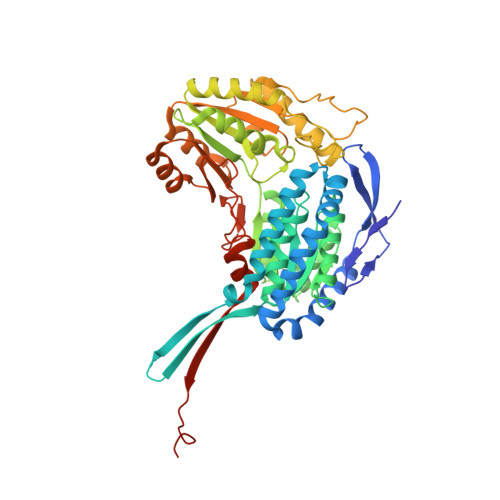Crystal structure and modeling of the tetrahedral intermediate state of methylmalonate-semialdehyde dehydrogenase (MMSDH) from Oceanimonas doudoroffii.
Do, H., Lee, C.W., Lee, S.G., Kang, H., Park, C.M., Kim, H.J., Park, H., Park, H., Lee, J.H.(2016) J Microbiol 54: 114-121
- PubMed: 26832667
- DOI: https://doi.org/10.1007/s12275-016-5549-2
- Primary Citation of Related Structures:
4ZZ7 - PubMed Abstract:
The gene product of dddC (Uniprot code G5CZI2), from the Gram-negative marine bacterium Oceanimonas doudoroffii, is a methylmalonate-semialdehyde dehydrogenase (OdoMMSDH) enzyme. MMSDH is a member of the aldehyde dehydrogenase superfamily, and it catalyzes the NAD-dependent decarboxylation of methylmalonate semialdehyde to propionyl-CoA. We determined the crystal structure of OdoMMSDH at 2.9 Å resolution. Among the twelve molecules in the asymmetric unit, six subunits complexed with NAD, which was carried along the protein purification steps. OdoMMSDH exists as a stable homodimer in solution; each subunit consists of three distinct domains: an NAD-binding domain, a catalytic domain, and an oligomerization domain. Computational modeling studies of the OdoMMSDH structure revealed key residues important for substrate recognition and tetrahedral intermediate stabilization. Two basic residues (Arg103 and Arg279) and six hydrophobic residues (Phe150, Met153, Val154, Trp157, Met281, and Phe449) were found to be important for tetrahedral intermediate binding. Modeling data also suggested that the backbone amide of Cys280 and the side chain amine of Asn149 function as the oxyanion hole during the enzymatic reaction. Our results provide useful insights into the substrate recognition site residues and catalytic mechanism of OdoMMSDH.
Organizational Affiliation:
Division of Polar Life Sciences, Korea Polar Research Institute, Incheon, 406-840, Republic of Korea.















